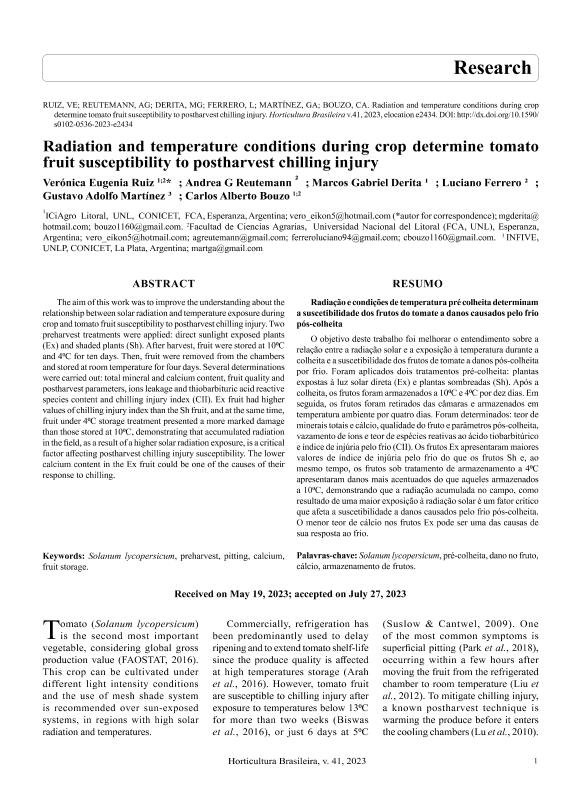Artículo
The aim of this work was to improve the understanding about the relationship between solar radiation and temperature exposure during crop and tomato fruit susceptibility to postharvest chilling injury. Two preharvest treatments were applied: direct sunlight exposed plants (Ex) and shaded plants (Sh). After harvest, fruit were stored at 10⁰C and 4⁰C for ten days. Then, fruit were removed from the chambers and stored at room temperature for four days. Several determinations were carried out: total mineral and calcium content, fruit quality and postharvest parameters, ions leakage and thiobarbituric acid reactive species content and chilling injury index (CII). Ex fruit had higher values of chilling injury index than the Sh fruit, and at the same time, fruit under 4⁰C storage treatment presented a more marked damage than those stored at 10⁰C, demonstrating that accumulated radiation in the field, as a result of a higher solar radiation exposure, is a critical factor affecting postharvest chilling injury susceptibility. The lower calcium content in the Ex fruit could be one of the causes of their response to chilling. O objetivo deste trabalho foi melhorar o entendimento sobre a relação entre a radiação solar e a exposição à temperatura durante a colheita e a suscetibilidade dos frutos de tomate a danos pós-colheita por frio. Foram aplicados dois tratamentos pré-colheita: plantas expostas à luz solar direta (Ex) e plantas sombreadas (Sh). Após a colheita, os frutos foram armazenados a 10⁰C e 4⁰C por dez dias. Em seguida, os frutos foram retirados das câmaras e armazenados em temperatura ambiente por quatro dias. Foram determinados: teor de minerais totais e cálcio, qualidade do fruto e parâmetros pós-colheita, vazamento de íons e teor de espécies reativas ao ácido tiobarbitúrico e índice de injúria pelo frio (CII). Os frutos Ex apresentaram maiores valores de índice de injúria pelo frio do que os frutos Sh e, ao mesmo tempo, os frutos sob tratamento de armazenamento a 4⁰C apresentaram danos mais acentuados do que aqueles armazenados a 10⁰C, demonstrando que a radiação acumulada no campo, como resultado de uma maior exposição à radiação solar é um fator crítico que afeta a suscetibilidade a danos causados pelo frio pós-colheita. O menor teor de cálcio nos frutos Ex pode ser uma das causas de sua resposta ao frio.
Radiation and temperature conditions during crop determine tomato fruit susceptibility to postharvest chilling injury
Título:
Radiação e condições de temperatura pré colheita determinam a suscetibilidade dos frutos do tomate a danos causados pelo frio pós-colheita
Ruiz, Verónica Eugenia ; Reutemann Arnolfo, Andrea Guadalupe
; Reutemann Arnolfo, Andrea Guadalupe ; Derita, Marcos Gabriel
; Derita, Marcos Gabriel ; Ferrero, Luciano; Martínez, Gustavo Adolfo; Bouzo, Carlos Alberto
; Ferrero, Luciano; Martínez, Gustavo Adolfo; Bouzo, Carlos Alberto
 ; Reutemann Arnolfo, Andrea Guadalupe
; Reutemann Arnolfo, Andrea Guadalupe ; Derita, Marcos Gabriel
; Derita, Marcos Gabriel ; Ferrero, Luciano; Martínez, Gustavo Adolfo; Bouzo, Carlos Alberto
; Ferrero, Luciano; Martínez, Gustavo Adolfo; Bouzo, Carlos Alberto
Fecha de publicación:
11/2023
Editorial:
Associação Brasileira de Horticultura
Revista:
Horticultura Brasileira
ISSN:
0102-0536
Idioma:
Inglés
Tipo de recurso:
Artículo publicado
Clasificación temática:
Resumen
Palabras clave:
CALCIUM
,
FRUIT STORAGE
,
PITTING
,
PREHARVEST
,
SOLANUM LYCOPERSICUM
Archivos asociados
Licencia
Identificadores
Colecciones
Articulos (ICIAGRO-Litoral)
Articulos de INSTITUTO DE CIENCIAS AGROPECUARIAS DEL LITORAL
Articulos de INSTITUTO DE CIENCIAS AGROPECUARIAS DEL LITORAL
Articulos(IBODA)
Articulos de INST.DE BOTANICA DARWINION (I)
Articulos de INST.DE BOTANICA DARWINION (I)
Articulos(INFIVE)
Articulos de INST.DE FISIOLOGIA VEGETAL
Articulos de INST.DE FISIOLOGIA VEGETAL
Citación
Ruiz, Verónica Eugenia; Reutemann Arnolfo, Andrea Guadalupe; Derita, Marcos Gabriel; Ferrero, Luciano; Martínez, Gustavo Adolfo; et al.; Radiation and temperature conditions during crop determine tomato fruit susceptibility to postharvest chilling injury; Associação Brasileira de Horticultura; Horticultura Brasileira; 41; 11-2023; 1-7
Compartir
Altmétricas



